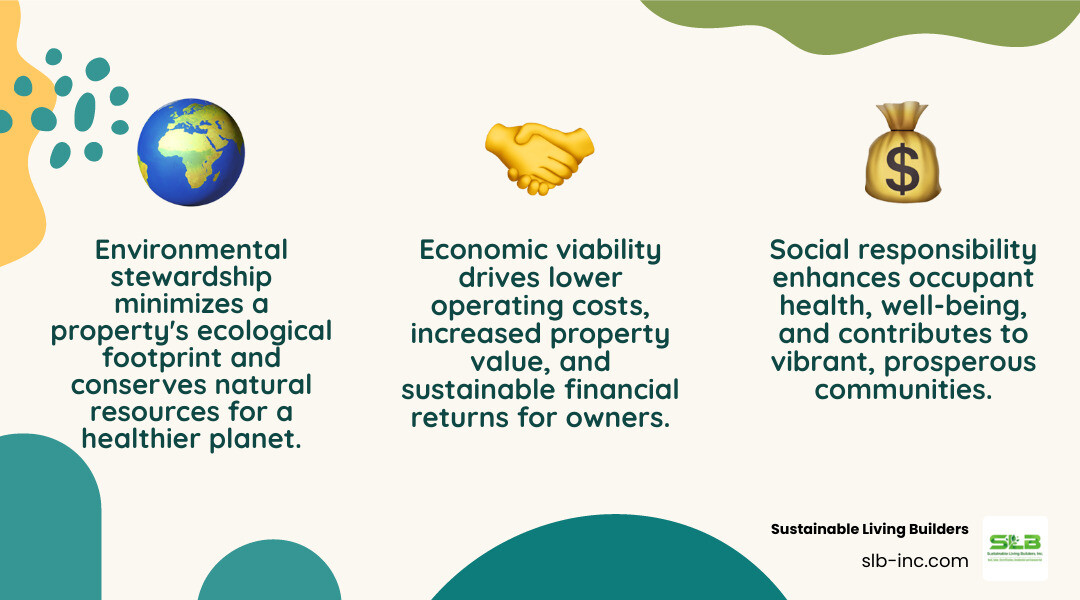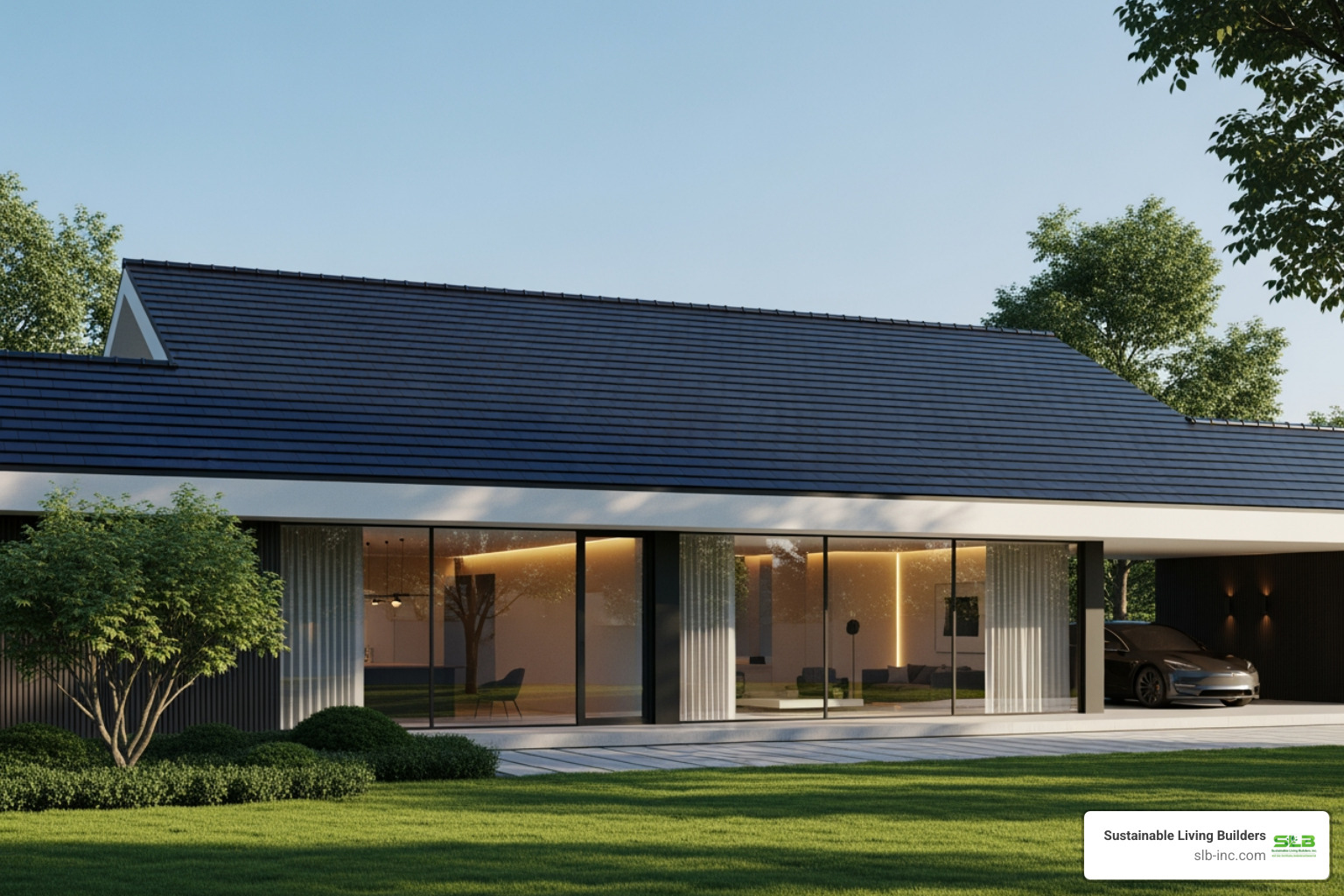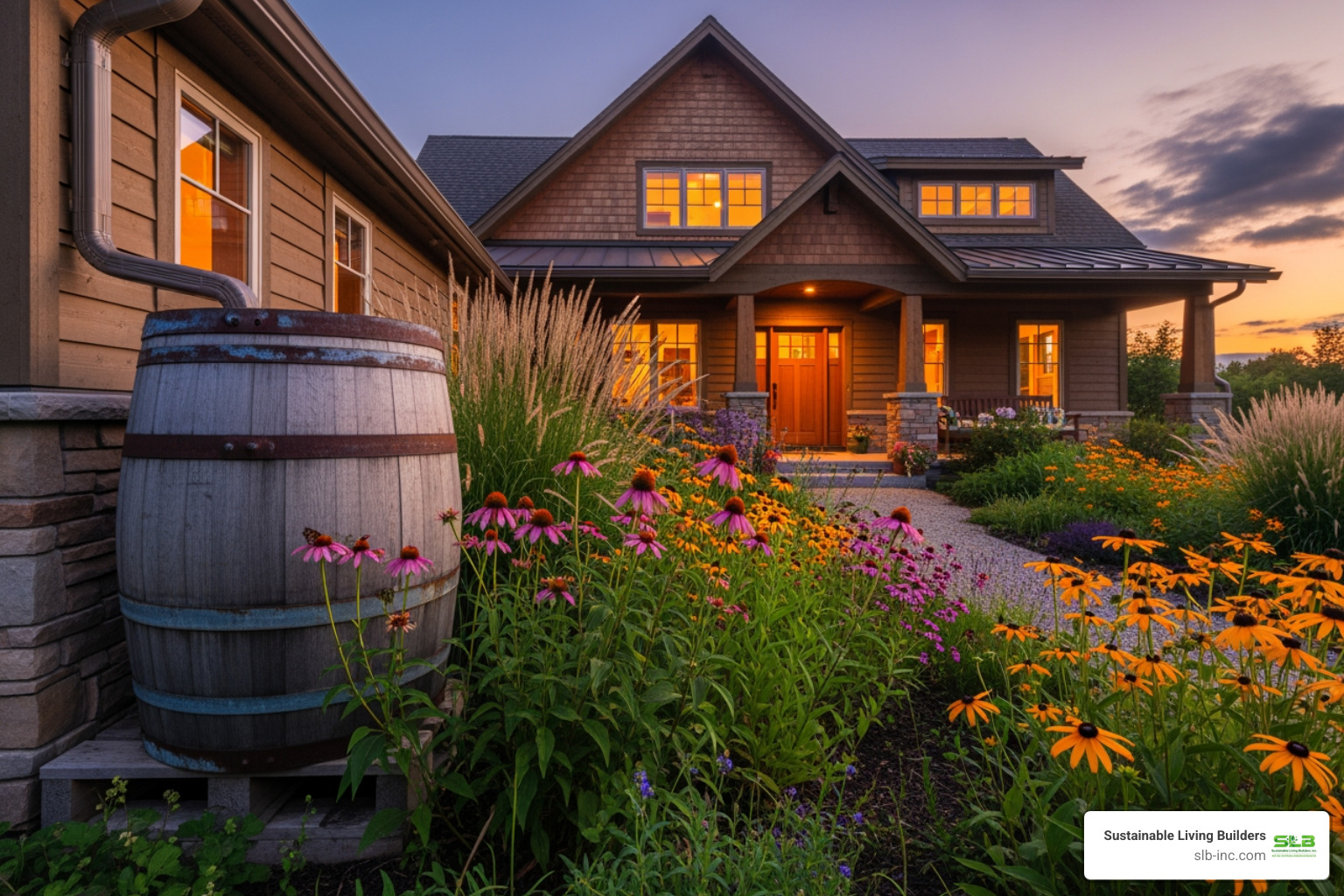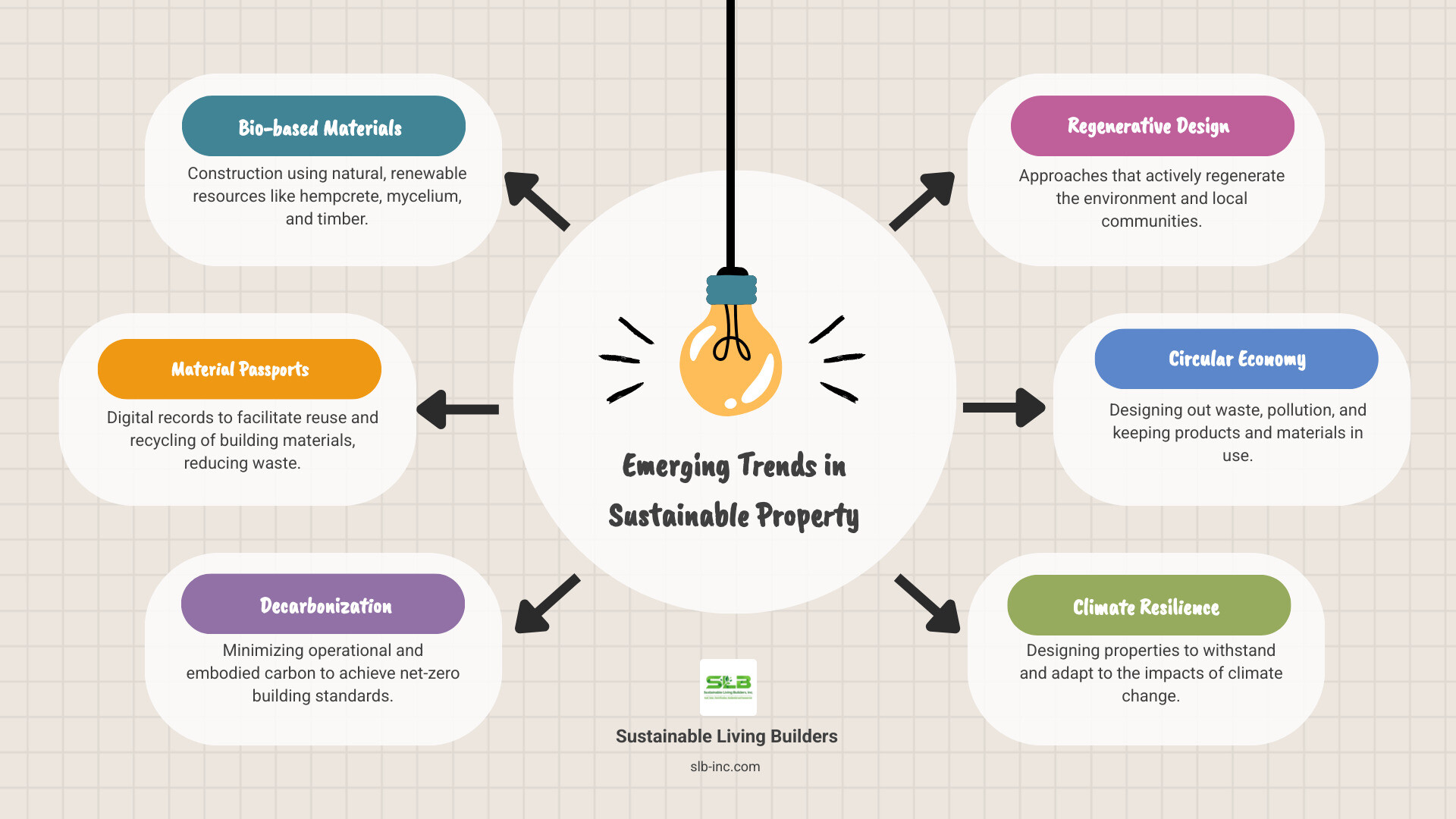The Core Pillars of Sustainable Property Management
Sustainable property solutions are practical upgrades that reduce a building’s environmental impact while lowering operating costs and improving occupant health. These improvements deliver real financial returns and create healthier living spaces, often paying for themselves faster than expected. The same upgrades that reduce environmental impact also slash utility bills, boost property value, and make your space more comfortable.
This guide breaks down the true value of sustainable property solutions beyond the environmental buzzwords, focusing on the upgrades that deliver the biggest bang for your buck and improve your home’s comfort and health.

At its heart, sustainability balances environmental stewardship, social responsibility, and economic viability—the “triple bottom line.” This means creating systems that thrive ecologically, socially, and economically. Sustainable property management integrates these principles throughout a property’s lifecycle, from design to operation, by making conscious choices to conserve resources and improve occupant well-being. For a deeper dive, explore our Guide to Sustainable Building Practices: Strategies & Trends.
Implementing Energy Efficiency Measures
Energy efficiency is one of the most impactful areas for sustainable property solutions. Our approach focuses on holistic solutions that drastically cut energy consumption, starting with the roof. We specialize in advanced options like the Tesla Solar Roof and traditional Solar Energy Systems, which turn your property into a power producer.
Beyond solar, we address all aspects of energy use:
- LED Lighting: A simple upgrade that dramatically reduces electricity use with long-lasting, high-quality light.
- Smart Thermostats: These devices learn your habits to optimize heating and cooling, saving energy without sacrificing comfort.
- High-Performance Insulation: As a cornerstone of efficiency, quality Importance of Sustainable Insulation maintains stable indoor temperatures and lowers HVAC demand.
- Energy Audits: A professional audit provides a data-driven roadmap to prioritize improvements for maximum impact.
- Home Electrification: Transitioning from fossil fuels to electric systems like heat pumps and induction cooktops, powered by solar, can create a zero-emission home. Learn more about Home Electrification.

Effective Water Conservation Strategies
In California, water conservation is vital. Reducing water use protects this precious resource, lowers utility bills, and saves the energy required to treat and deliver water.
Effective strategies include:
- Low-Flow Fixtures: Modern toilets, showerheads, and faucets cut water usage without compromising performance.
- Drought-Tolerant Landscaping: Native and drought-resistant plants beautify your property while requiring minimal irrigation.
- Rainwater Harvesting Systems: Collecting rainwater provides a free water source for gardens and other non-potable uses.
- Smart Irrigation Controls: These systems use weather and soil data to water landscapes precisely, preventing waste.
- Leak Detection: Regular inspections and smart detectors find and fix leaks promptly, saving water and preventing damage.

Best Practices for Waste Reduction and Recycling
Minimizing waste is another critical pillar of sustainable property solutions. Our goal is to divert as much waste as possible from landfills, promoting a circular economy where resources are reused and recycled. We also explore innovative approaches to material use, such as those promoted by a Circular Economy Tool, to maximize resource efficiency.
Best practices include:
- Comprehensive Recycling Programs: Establish clearly labeled bins and educate occupants on proper sorting.
- Composting Initiatives: Turn food scraps and yard trimmings into nutrient-rich soil, reducing landfill methane emissions.
- Construction Waste Management: During projects, we prioritize sorting, recycling, and salvaging materials like wood, metal, and concrete.
- Promoting Reusable Materials: Encourage durable, long-lasting materials over single-use items in daily life and property upgrades.
The Financial & Experiential Value of Sustainable Property Solutions
While the environmental benefits are important, the financial returns and day-to-day improvements of sustainable property solutions often surprise homeowners the most. Investing in energy-efficient upgrades is a smart financial decision that also makes your home a healthier, more pleasant place to live. The value appears in lower utility bills, increased property value, and improved comfort. These aren’t luxuries—they’re the everyday benefits of thoughtful, sustainable practices that can lead to lower operating costs.
Boosting Your Bottom Line and Property Value
Sustainable upgrades are investments that return value over time. Here’s how they benefit homeowners in Santa Rosa, Sebastopol, Sonoma County, Marin County, and Napa County:
- Reduced Utility Bills: Energy-efficient roofing, solar panels, and water-saving fixtures directly lower monthly electricity, gas, and water costs. Combining solar with proper insulation can lead to significant savings. Our article on Are Solar Panels Worth It? explores the real numbers.
- Tax Incentives and Rebates: Federal, state, and local programs offer financial support for upgrades like solar installations and high-performance HVAC systems, offsetting a portion of the initial investment.
- Increased Property Value: Homes with sustainable features command higher prices and sell faster. Buyers recognize the long-term savings and modern efficiency, and the Advantages of Sustainable Roofing signal quality and durability.
- Lower Vacancy Rates: For rental properties, eco-friendly homes with lower utility bills attract quality tenants who stay longer, reducing turnover costs.
Enhancing Occupant Health, Well-Being, and Satisfaction
The health and comfort benefits of sustainable property solutions are immediate and substantial.
- Improved Indoor Air Quality: Using low-VOC materials and better ventilation leads to cleaner air, fewer headaches, and reduced allergy symptoms. This is especially important for children and those with respiratory sensitivities.
- More Natural Light: Maximizing daylight with well-placed windows and skylights saves electricity while boosting mood and making rooms more inviting.

Research confirms these benefits. Studies show that occupants of green buildings experience fewer sick days and reduced symptoms of asthma and stress. These advantages apply directly to your home, as noted in a survey by the U.S. Green Building Council.
- Temperature Stability: Proper insulation and efficient HVAC systems eliminate cold spots and overheating, maintaining consistent comfort throughout your home.
- Improved Lifestyle with Green Amenities: Features like EV charging stations, bike-friendly access, and community gardens support a healthier, more connected lifestyle and improve how you live every day.
Putting Sustainability into Practice
Making a property sustainable requires creating a complete system. This involves integrating smart technology, practicing green procurement, and engaging the community to create lasting change. For insights into how larger properties are leading the way, see our article on how Commercial Buildings Adopt Sustainability.
The Role of Technology in Sustainable Property Management
Today’s technology makes sustainable property solutions accessible and user-friendly. Smart systems learn your habits and adjust automatically to save energy without sacrificing comfort.
- Building Management Systems (BMS): For larger properties, a BMS acts as a central nervous system, optimizing heating, cooling, and lighting to ensure energy is used efficiently.
- Smart Thermostats: These devices learn your schedule and preferences, making small adjustments that lead to significant energy savings.
- Energy Storage Batteries: Systems like Energy Storage Batteries store excess solar energy generated during the day for use at night, increasing energy independence. Learn more in our guide on Powering Your Future with Tesla’s Solar Solutions.
- IoT Sensors: These small devices monitor conditions like temperature, humidity, and water flow, catching problems early and helping systems run more efficiently.
- Energy Monitoring Software: This software provides clear data on energy consumption, helping you identify where you’re losing money and which upgrades will be most effective.
Integrating Green Procurement and Engaging Stakeholders
True sustainability extends beyond technology to the materials we use and the people who inhabit our properties.
- Green Procurement: This means thoughtfully sourcing materials that are recycled, locally produced, non-toxic, and have a minimal environmental footprint. We also partner with vendors who share our commitment to sustainability.
- Resident Education: Clear information and simple systems are key to encouraging participation in recycling and composting programs. We provide guidelines and support to make sustainable living feel natural.
- Community Amenities: Community gardens bring people together and reduce the carbon footprint of food. As electric vehicles become more common, EV charging stations are shifting from a luxury to a necessity. The trend of providing green amenities is accelerating as more people prioritize sustainability.
Together, smart technology, thoughtful purchasing, and engaged communities create properties that contribute to healthier, more connected neighborhoods.
The Future of Sustainable Real Estate
The real estate industry is shifting from simply “doing less harm” to creating buildings that actively contribute to environmental and social well-being. Sustainable property solutions are evolving rapidly, incorporating regenerative design, circular economy models, net-zero energy, and climate resilience. As highlighted by Trends in Sustainable Solutions for the Built Environment 2024, innovation is accelerating, making cutting-edge ideas today’s standard practice.
Key Considerations for Different Property Types
Sustainable property solutions must be custom to the specific property. A vacation rental has different priorities than a commercial building or a private home.
- Commercial Real Estate: Environmental, Social, and Governance (ESG) criteria are now essential. Businesses seek properties with green certifications and features like renewable energy and biophilic design, which attract high-quality tenants and command premium rates.
- Vacation Rentals: Owners can tap into the eco-tourism market by offering energy-efficient features and eco-conscious amenities. These properties stand out, generate better reviews, and encourage repeat bookings.
- Residential Homeowners: The benefits are personal and tangible: lower utility bills, improved comfort, better air quality, and increased property value. Our guide on Foolproof Choices for Every Sustainable Living Home shows how these upgrades improve daily life.
Emerging Trends in sustainable property solutions
Several exciting trends are moving from experimental to mainstream.
- Bio-based Materials: Materials derived from renewable resources like hemp, mycelium, and sustainable timber offer a low-carbon alternative to conventional options and can improve indoor air quality.
- Material Passports: These digital records document a building’s materials to guide future reuse and recycling, changing construction waste into a resource stream.
- Decarbonization: The push toward net-zero buildings is intensifying, with standards like the UK Net Zero Carbon Buildings Standard setting ambitious goals. This involves reducing both operational energy and the embodied carbon in construction materials. As our article on The Evolution of Roofing Trends to Watch in 2024 and Beyond explains, roofing systems play a pivotal role in this strategy.
Here’s how traditional and sustainable building materials compare:
| Feature | Traditional Building Materials | Sustainable Building Materials |
|---|---|---|
| Source | Virgin, often non-renewable | Recycled, rapidly renewable, bio-based |
| Embodied Carbon | High (e.g., concrete is 8% of global emissions) | Lower |
| Waste Generation | High | Low, focus on reuse and recycling |
| Toxicity | Can contain VOCs and harmful chemicals | Low-VOC, non-toxic |
| Energy Efficiency | Variable, often lower | High, contributes to better insulation and performance |
| End-of-Life | Landfill | Recycled, composted, or reused |
The future of real estate is about creating environments where people and the planet can thrive. That future is being built today, one thoughtful upgrade at a time.

Frequently Asked Questions about Sustainable Property Solutions
What is the first step to making my property more sustainable?
The best first step is a professional energy audit. Think of it as a health checkup for your home. It takes the guesswork out of the process by revealing exactly where you’re losing energy and which upgrades will provide the biggest return on investment. An audit provides a clear, data-driven roadmap custom to your property, allowing you to prioritize improvements like sealing air leaks, adding insulation, or upgrading appliances for maximum impact.
Are sustainable upgrades only for new buildings?
Not at all. While new builds can incorporate green features from the start, retrofitting existing buildings is one of the most impactful ways to improve sustainability. Upgrading older properties is critical for reducing our collective environmental footprint. Adding solar panels, high-performance insulation, or water-saving fixtures can transform an older, inefficient house. These upgrades can be done in stages, allowing you to make meaningful improvements over time as your budget allows.
How do sustainable practices benefit me as a homeowner?
Sustainable property solutions offer tangible, day-to-day benefits beyond helping the environment. As a homeowner, you can expect:
- Lower Utility Bills: Energy-efficient systems and better insulation work together to slash your monthly energy costs.
- Increased Comfort: Enjoy more stable indoor temperatures, fewer drafts, and brighter spaces with more natural light.
- Better Health: Improved indoor air quality from low-VOC materials and better ventilation can reduce allergies and respiratory irritation.
- Higher Property Value: Sustainable homes are attractive to buyers, often selling faster and at higher prices due to their long-term savings and modern features.
- Reduced Carbon Footprint: Live in harmony with your values by making choices that contribute to a healthier planet for future generations.
Conclusion
Making your property more sustainable is about creating a home that works better for you, your wallet, and the planet. Sustainable property solutions deliver lower monthly bills, a healthier living space, and a reduced environmental impact. By taking a holistic approach that combines energy efficiency, water conservation, waste reduction, and smart technology, you can achieve results that far exceed any single upgrade.
The financial benefits are clear: reduced utility bills, a higher property value, and access to tax incentives. Beyond the numbers, you’ll experience improved indoor air quality, greater comfort from stable temperatures, and the mood-boosting effects of natural light. These are not just features; they are daily quality-of-life improvements.
At Sustainable Living Builders, we have seen these changes across Santa Rosa, Sebastopol, Sonoma County, Marin County, and Napa County. We provide expert-guided solutions to lower your energy costs and carbon footprint, making your property future-ready. The future of real estate is sustainable, and by starting your journey today, you are investing in a property that will thrive for decades.
Ready to explore what sustainable property solutions can do for your home? Visit our Sustainability page to learn more, or reach out to discuss how we can help transform your property into the efficient, comfortable, and valuable space you deserve.
